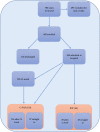Role of SatO2, PaO2/FiO2 Ratio and PaO2 to Predict Adverse Outcome in COVID-19: A Retrospective, Cohort Study
- PMID: 34770046
- PMCID: PMC8582831
- DOI: 10.3390/ijerph182111534
Role of SatO2, PaO2/FiO2 Ratio and PaO2 to Predict Adverse Outcome in COVID-19: A Retrospective, Cohort Study
Abstract
COVID-19 respiratory failure is a life-threatening condition. Oxygenation targets were evaluated in a non-ICU setting. In this retrospective, observational study, we enrolled all patients admitted to the University Hospital of Genoa, Italy, between 1 February and 31 May 2020 with an RT-PCR positive for SARS-CoV-2. PaO2, PaO2/FiO2 and SatO2% were collected and analyzed at time 0 and in case of admission, patients who required or not C-PAP (groups A and B) were categorized. Each measurement was correlated to adverse outcome. A total of 483 patients were enrolled, and 369 were admitted to hospital. Of these, 153 required C-PAP and 266 had an adverse outcome. Patients with PaO2 <60 and >100 had a higher rate of adverse outcome at time 0, in groups A and B (OR 2.52, 3.45, 2.01, respectively). About the PaO2/FiO2 ratio, the OR for < 300 was 3.10 at time 0, 4.01 in group A and 4.79 in group B. Similar odds were found for < 200 in any groups and < 100 except for group B (OR 11.57). SatO2 < 94% showed OR 1.34, 3.52 and 19.12 at time 0, in groups A and B, respectively. PaO2 < 60 and >100, SatO2 < 94% and PaO2/FiO2 ratio < 300 showed at least two- to three-fold correlation to adverse outcome. This may provide simple but clear targets for clinicians facing COVID-19 respiratory failure in a non ICU-setting.
Keywords: COVID-19; hyperoxia; hypoxia; non-invasive ventilation; respiratory failure.
Conflict of interest statement
The authors declare no conflict of interest.
Figures
References
-
- Moghadas S.M., Shoukat A., Fitzpatrick M., Wells C.R., Sah P., Pandey A., Sachs J.D., Wang Z., Meyers L.A., Singer B.H., et al. Projecting hospital utilization during the COVID-19 outbreaks in the United States. Proc. Natl. Acad. Sci. USA. 2020;117:9122–9126. doi: 10.1073/pnas.2004064117. - DOI - PMC - PubMed
-
- Wang X., Fang X., Cai Z., Wu X., Gao X., Min J., Wang F. Comorbid Chronic Diseases and Acute Organ Injuries Are Strongly Correlated with Disease Severity and Mortality among COVID-19 Patients: A Systemic Review and Meta-Analysis. Research. 2020;2020:2402961. doi: 10.34133/2020/2402961. - DOI - PMC - PubMed
-
- Zhou F., Yu T., Du R., Fan G., Liu Y., Liu Z., Xiang J., Wang Y., Song B., Gu X., et al. Clinical course and risk factors for mortality of adult inpatients with COVID-19 in Wuhan, China: A retrospective cohort study. Lancet. 2020;395:1054–1062. doi: 10.1016/S0140-6736(20)30566-3. - DOI - PMC - PubMed
Publication types
MeSH terms
Substances
LinkOut - more resources
Full Text Sources
Medical
Research Materials
Miscellaneous


